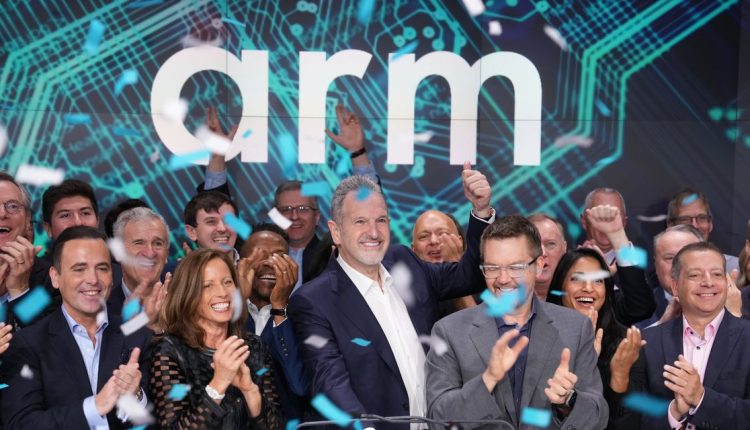Arm’s stock soars 25% in public debut as execs sees big opportunity to drive cost savings for chip makers
U.S.-listed shares of Arm Holdings PLC surged out of the gate Thursday and closed 25% above their pricing after they began trading on the Nasdaq, following a long-awaited initial public offering.
Arm’s American depositary receipts
ARM,
began trading Thursday just after noon Eastern, opening at $56.10 and rallying as much as 30% above their initial public offering price of $51. By the end of the day, shares finished up 24.7% at $63.59, according to FactSet, giving Arm a market capitalization of more than $65 billion based on 1.03 billion shares outstanding.
Arm priced those shares at the high end of its expected range Wednesday.
Then, ADRs appeared to get a second wind after the close, rising more than 5% after hours.
Chief Financial Officer Jason Child told MarketWatch on Thursday that Arm’s focus going forward would be to take advantage of the skyrocketing costs of making smaller and smaller nanometer-sized transistors for chips. As transistors get smaller, the cost for intellectual property and software verification has ballooned to take up as much as three-quarters of the design cost, he said.
Rather than take on that cost themselves, chip makers are starting to farm that out to Arm, he said.
“It’s allowing us to do the work, and then monetize the work that we do — for IP verification, software verification — we do that and sell it to everyone else at a fraction of the price what it would cost for them to do it on their own,” Child told MarketWatch.
“What it does is it allows us to actually get higher royalty rates over time because of the cost savings folks are getting by using us versus trying to maybe do more of the work on their own,” Child said.
The CFO said this is part of why Arm is getting more business designing full compute subsystems rather than just providing instruction sets for central-programming units.
“As a result, we’re seeing more customers wanting to take us up on that offer, because it’s saving them a lot of time and a lot of money,” Child told MarketWatch.
While Arm’s IPO was reportedly several times oversubscribed, it was also met with anxiety over what appeared to be a high vulnerability to geopolitical tensions should a trade war heat up between the U.S. and China.
Child told MarketWatch that much of the company’s relevant risk-factor language was at the behest of lawyers mulling over worst case scenarios. In the company’s filing, Arm said its China business “operates independently of us,” and that exposed the company to “significant risks.”
“That said, it’s China,” Child told MarketWatch. The CFO said that having overseen China operations at four different global companies, “this is the smoothest of any of my experience with China.”
Read: Arm prices IPO at high end of range, raising $4.87 billion
“Generally, the whole thing between China and U.S. is there doesn’t seem to be completely aligned incentives,” Child said, noting that tensions between the U.S. and China are a problem for the semiconductor industry as a whole, and are not Arm specific.
“We are a U.K.-based company, and most of our IP is designed outside of the U.S. so we might be a little bit different from that perspective, but for the most part, it’s pretty similar,” Child told MarketWatch.
Read: Arm IPO: 5 things to know about the chip designer central to the AI transition
Over fiscal years 2023, 2022 and 2021, revenue from China-based customers accounted for about 25%, 18% and 20%, respectively, of Arm’s total. Revenue from Taiwan-based customers accounted for 13.4%, 15.9% and 15.1%, respectively.
That looks fairly standard, as Nvidia Corp.
NVDA,
derives 21% of its revenue from China and 25.9% from Taiwan, according to FactSet data. Additionally, Advanced Micro Devices Inc.
AMD,
gets 21.6% of its revenue from China, and 10% from Taiwan.
With the quarter ending on Sept. 30, Child said the company expects to deliver its first earnings report in November. The company intends to post results “in conjunction with SoftBank since they own 90% of the company,” he added.
In fiscal 2023, which ended March 31, Arm said R&D costs amounted to 41% of revenue, up from 37% in 2022 and 40% in 2021. R&D costs rose 13.9% to $1.13 billion in 2023, as revenue slipped less than 1% to $2.68 billion, according to Arm.
A group of “cornerstone investors” led by Nvidia, AMD, Apple Inc.
AAPL,
Alphabet Inc.’s
GOOG,
GOOGL,
Google followed through with and bought about $735 million in American depositary shares at the same terms as other purchasers, Arm confirmed.
Plans for an IPO started after Nvidia Chief Executive Jensen Huang officially pulled the plug on his foundering $40 billion offer to buy Arm outright from SoftBank Group Corp.
9984,
in February 2022, after the FTC joined regulators opposing the deal by suing to block it a few months earlier. Right after the breakup, SoftBank announced it would take Arm public by March 31, 2024.
In 2016, Arm was purchased by SoftBank for $32 billion.
Read the full article here

